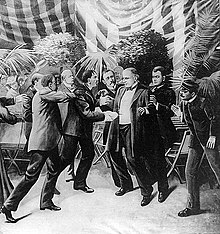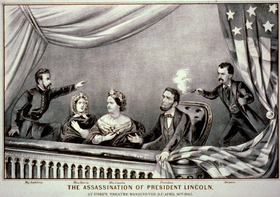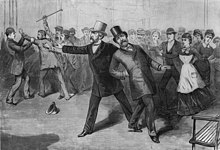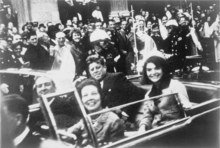List of Presidents of the United States who died in office
William Henry Harrison holds the record for shortest term served, holding the office of presidency for 31 days before dying. Harrison was the first president to die while in office when he caught pneumonia and died on April 4, 1841.[4] On July 9, 1850, Zachary Taylor died from acute gastroenteritis.[5] Abraham Lincoln was the first president to be assassinated. He was shot behind his left ear by John Wilkes Booth on April 14, 1865.[6] Sixteen years later, on September 19, 1881, President James A. Garfield was assassinated by Charles Julius Guiteau.[7] Nearly twenty years after that, President William McKinley died from complications after being shot twice by Leon Czolgosz.[8] President Warren G. Harding suffered a heart attack, and died on August 2, 1923.[9] On April 12, 1945, Franklin Delano Roosevelt collapsed and died as a result of a cerebral hemorrhage.[10] The most recent president to die in office was John F. Kennedy, who was assassinated with two rifle shots on November 22, 1963, in Dallas, Texas.[11]
William Henry Harrison
The cold worsened, rapidly turning to pneumonia and pleurisy.[12] He sought to rest in the White House, but could not find a quiet room because of the steady crowd of office seekers. His extremely busy social schedule made any rest time scarce.[13]
Harrison's doctors tried cures, applying opium, castor oil, leeches, and Virginia snakeweed. But the treatments only made Harrison worse, and he became delirious. He died nine days after becoming ill,[14] at 12:30 am on April 4, 1841, of right lower lobe pneumonia, jaundice, and overwhelming septicemia. He was the first United States president to die in office. His last words were to his doctor, but assumed to be directed at John Tyler, "Sir, I wish you to understand the true principles of the government. I wish them carried out. I ask nothing more." Harrison served the shortest term of any American president: March 4 – April 4, 1841, 30 days, 12 hours, and 30 minutes.[15][16]
Harrison's funeral took place in the Wesley Chapel in Cincinnati, Ohio, on April 7, 1841.[17] His original interment was in the public vault of the Congressional Cemetery in Washington, D.C. He was later buried in North Bend, Ohio. The William Henry Harrison Tomb State Memorial was erected in his honor.[18]
Zachary Taylor
Taylor was interred in the Public Vault of the Congressional Cemetery in Washington, D.C. from July 13, 1850 to October 25, 1850. (It was built in 1835 to hold remains of notables until either the grave site could be prepared or transportation arranged to another city.) His body was transported to the Taylor Family plot where his parents are buried, on the old Taylor homestead plantation known as 'Springfield' in Louisville, Kentucky.[23]
In 1883, the Commonwealth of Kentucky placed a fifty-foot monument in his honor near his grave; it is topped by a life-sized statue of Taylor. By the 1920s, the Taylor family initiated the effort to turn the Taylor burial grounds into a national cemetery. The Commonwealth of Kentucky donated two pieces of land for the project, turning the half-acre Taylor family cemetery into 16 acres (65,000 m2). On May 6, 1926, the remains of Taylor and his wife (who died in 1852) were moved to the newly constructed Taylor mausoleum nearby. (It was made of limestone with a granite base, with a marble interior.) The cemetery property has been designated as the Zachary Taylor National Cemetery.[24]
Abraham Lincoln
Main article: Assassination of Abraham Lincoln
The assassination of Abraham Lincoln took place on Good Friday,[25] April 14, 1865, as the American Civil War was drawing to a close. The assassination occurred five days after the commanding General of the Army of Northern Virginia, Robert E. Lee, surrendered to General Ulysses S. Grant and the Army of the Potomac. Lincoln was the first American president to be assassinated,[26] though an unsuccessful attempt had been made on Andrew Jackson thirty years before in 1835. The assassination was planned and carried out by the well-known stage actor John Wilkes Booth, as part of a larger conspiracy in a bid to revive the Confederate cause. Booth's co-conspirators were Lewis Powell and David Herold, who were assigned to kill Secretary of State William H. Seward, and George Atzerodt who was to kill Vice President Andrew Johnson.
By simultaneously eliminating the top three people in the
administration, Booth and his co-conspirators hoped to sever the
continuity of the United States government.Lincoln was shot while watching the play Our American Cousin with his wife Mary Todd Lincoln at Ford's Theatre in Washington, D.C. on the night of April 14, 1865.[27] An army surgeon, Doctor Charles Leale, saw that Lincoln's wound was mortal. The President was taken across the street from the theater to the Petersen House, where he lapsed into a coma for nine hours before dying early the next morning.[28] The rest of the conspirators' plot failed; Powell only managed to wound Seward, while Atzerodt, Johnson's would-be assassin, lost his nerve and fled Washington.
James A. Garfield
Main article: Assassination of James A. Garfield
The assassination of James A. Garfield took place in Washington, D.C. on July 2, 1881.[31] Garfield was shot by Charles J. Guiteau at 9:30 am, less than four months into Garfield's term as the 20th President of the United States. Garfield died eleven weeks later on September 19, 1881. His Vice President, Chester A. Arthur, succeeded Garfield as President. Garfield also lived the longest after the shooting, compared to other Presidents.Garfield was scheduled to leave Washington on July 2, 1881 for his summer vacation.[32] On that day, Guiteau lay in wait for the President at the Baltimore and Potomac Railroad station, on the southwest corner of present day Sixth Street and Constitution Avenue NW, Washington, D.C.[33]
President Garfield came to the Sixth Street Station on his way to his alma mater, Williams College, where he was scheduled to deliver a speech. Garfield was accompanied by two of his sons, James and Harry, and Secretary of State Blaine. Secretary of War Robert Todd Lincoln waited at the station to see the President off.[34] Garfield had no bodyguard or security detail; with the exception of Abraham Lincoln during the Civil War, early U.S. presidents never used any guards.[35]
As President Garfield entered the waiting room of the station Guiteau stepped forward and pulled the trigger from behind at point-blank range. "My God, what is that?" Garfield cried out, flinging up his arms. Guiteau fired again and Garfield collapsed.[36] One bullet grazed Garfield's shoulder; the other hit him in the back, passing the first lumbar vertebra but missing the spinal cord before coming to rest behind his pancreas.[37]
Garfield, conscious but in shock, was carried to an upstairs floor of the train station.[38] One bullet remained lodged in his body, but doctors could not find it.[39] Young Jim Garfield and James Blaine both broke down and wept. Robert Todd Lincoln, deeply upset and thinking back to the death of his father, said "How many hours of sorrow I have passed in this town."[39]
Garfield was carried back to the White House. Although doctors told him that he would not survive the night, the President remained conscious and alert.[40] The next morning his vital signs were good and doctors began to hope for recovery.[41] A long vigil began, with Garfield's doctors issuing regular bulletins that the American public followed closely throughout the summer of 1881.[42][43] His condition fluctuated. Fevers came and went. Garfield struggled to keep down solid food and spent most of the summer eating little, and that only liquids.[44]
Chester Arthur was at his home in New York City when word came the night of September 19 that Garfield had died. After first getting the news, Arthur said "I hope—my God, I do hope it is a mistake." But confirmation by telegram came soon after. Arthur took the presidential oath of office, administered by a New York Supreme Court judge, then left for Long Branch to pay his respects before going on to Washington.[45] Garfield's body was taken to Washington, where it lay in state for two days in the Capitol Rotunda before being taken to Cleveland, where the funeral was held on September 26.[46]
William McKinley

Leon Czolgosz shoots President McKinley with a concealed revolver. Clipping of a wash drawing by T. Dart Walker.
Main article: Assassination of William McKinley
William McKinley was assassinated on September 6, 1901, inside the Temple of Music on the grounds of the Pan-American Exposition in Buffalo, New York. McKinley was shaking hands with the public when he was shot by Leon Czolgosz, an anarchist. The President died on September 14 from gangrene caused by the bullet wounds.[8]McKinley had been elected for a second term in 1900.[47] He enjoyed meeting the public, and was reluctant to accept the security available to his office.[48] The Secretary to the President, George B. Cortelyou, feared an assassination attempt would take place during a visit to the Temple of Music, and twice took it off the schedule. McKinley restored it each time.[49]
Czolgosz had lost his job during the economic Panic of 1893 and turned to anarchism, a political philosophy whose adherents had killed foreign leaders.[50] Regarding McKinley as a symbol of oppression, Czolgosz felt it was his duty as an anarchist to kill him.[51] Unable to get near McKinley during the earlier part of the presidential visit, Czolgosz shot McKinley twice as the President reached to shake his hand in the reception line at the temple. One bullet grazed McKinley; the other entered his abdomen and was never found.[8]
McKinley initially appeared to be recovering, but took a turn for the worse on September 13 as his wounds became gangrenous, and died early the next morning; Vice President Theodore Roosevelt succeeded him.[52] After McKinley's murder, for which Czolgosz was put to death in the electric chair, the United States Congress passed legislation to officially charge the Secret Service with the responsibility for protecting the president.[53]
Warren G. Harding
Immediately after President Harding's death, Mrs. Harding returned to Washington, D.C., and briefly stayed in the White House with President and First Lady Coolidge. For a month, former First Lady Harding gathered and destroyed by fire President Harding's correspondence and documents, both official and unofficial. Upon her return to Marion, Mrs. Harding hired a number of secretaries to collect and burn President Harding's personal papers. According to Mrs. Harding, she took these actions to protect her husband's legacy. The remaining papers were held and kept from public view by the Harding Memorial Association in Marion.[56]
Franklin D. Roosevelt
On March 29, 1945, Franklin D. Roosevelt went to the Little White House at Warm Springs, Georgia, to rest before his anticipated appearance at the founding conference of the United Nations. On the afternoon of April 12, Roosevelt said, "I have a terrific pain in the back of my head." He then slumped forward in his chair, unconscious, and was carried into his bedroom. The president's attending cardiologist, Dr. Howard Bruenn, diagnosed a massive cerebral hemorrhage (stroke).[57] At 3:35 pm that day, Roosevelt died. As Allen Drury later said, “so ended an era, and so began another.” After Roosevelt's death, an editorial by The New York Times declared, "Men will thank God on their knees a hundred years from now that Franklin D. Roosevelt was in the White House".[58]At the time he collapsed, Roosevelt had been sitting for a portrait painting by the artist Elizabeth Shoumatoff, known as the famous Unfinished Portrait of FDR.
On the morning of April 13, Roosevelt's body was placed in a flag-draped coffin and loaded onto the presidential train. After a White House funeral on April 14, Roosevelt was transported back to Hyde Park by train, guarded by four servicemen, one each from the Army, Navy, Marines, and Coast Guard. As was his wish, Roosevelt was buried in the Rose Garden of the Springwood estate, the Roosevelt family home in Hyde Park on April 15. Eleanor died in November 1962 and was buried next to him.[60]
Roosevelt's death was met with shock and grief[61] across the U.S. and around the world. His declining health had not been known to the general public. Roosevelt had been president for more than 12 years, longer than any other person, and had led the country through some of its greatest crises to the impending defeat of Nazi Germany and within sight of the defeat of Japan as well.
Less than a month after his death, on May 8, the war in Europe ended. President Harry S. Truman, who turned 61 that day, dedicated Victory in Europe Day and its celebrations to Roosevelt's memory, and kept the flags across the U.S. at half-staff for the remainder of the 30-day mourning period. In doing so, Truman said that his only wish was "that Franklin D. Roosevelt had lived to witness this day."[62]
John F. Kennedy
Main article: Assassination of John F. Kennedy
John F. Kennedy was assassinated at 12:30 p.m. Central Standard Time (18:30 UTC) on Friday, November 22, 1963, in Dealey Plaza, Dallas, Texas.[63][64] Kennedy was fatally shot while traveling with his wife Jacqueline, Texas Governor John Connally, and the latter's wife Nellie, in a Presidential motorcade. The ten-month investigation by the Warren Commission concluded that Kennedy was assassinated by Lee Harvey Oswald acting alone and that Jack Ruby
acted alone when he killed Oswald before he could stand trial.
Nonetheless, polls conducted from 1966 to 2004 found that as many as 80
percent of Americans have suspected that there was a plot or cover-up.[65][66]Contrary to the Warren Commission, the United States House Select Committee on Assassinations (HSCA) ruled that Kennedy was probably assassinated as a result of a conspiracy.[67] The HSCA found both the original FBI investigation and the Warren Commission Report to be seriously flawed. While agreeing with the Commission that Oswald fired all the shots which caused the wounds to Kennedy and Connally, the HSCA stated that there were at least four shots fired and that there was "...a high probability that two gunmen fired at [the] President."[68] The HSCA did not identify any other person or group involved in the assassination besides Oswald, but they did specifically say the CIA, the Soviet Union, organized crime, and several other groups were not involved, although they could not rule out the involvement of individual members of those groups. Kennedy's assassination is still the subject of widespread debate and has spawned numerous conspiracy theories and alternative scenarios.










No comments:
Post a Comment